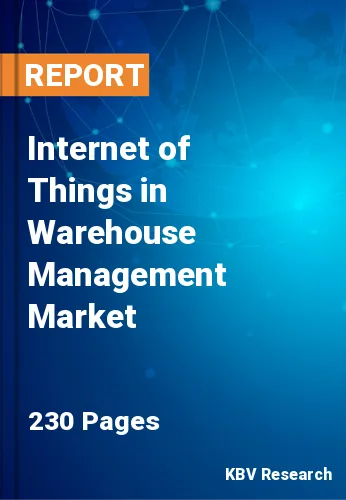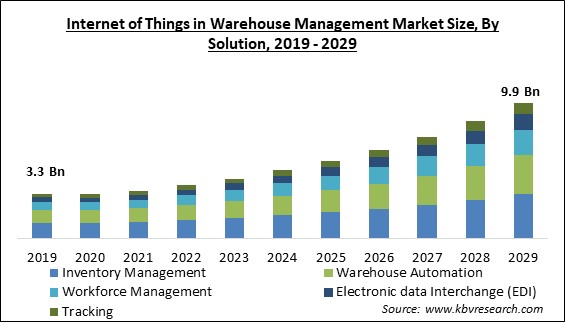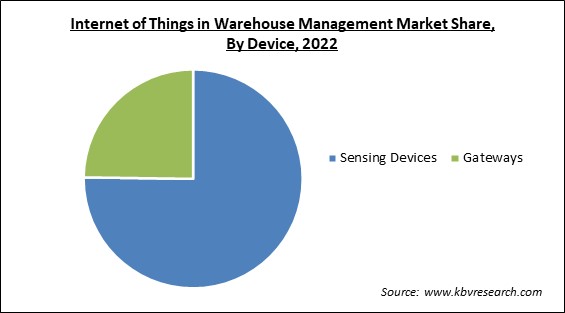
The Global Internet of Things in Warehouse Management Market size is expected to reach $9.9 Billion by 2029, rising at a market growth of 14.5% CAGR during the forecast period.
In the logistics industry, a new trend is the application of Internet of Things (IoT) to warehouse management. Businesses rely heavily on smart technologies to simplify automated operations and inventory management. Also, it increases productivity inside the firm and lowers operating costs. Supply chain effectiveness and on-time delivery of promises are two aspects that greatly influence the customer experience. Using IoT lowers labor expenses and speeds up shipping, improving customer satisfaction.

In essence, warehouses store goods and other items that must be delivered to clients. The fundamental goal of storage is to keep the goods secure and deliver them when needed. In order to streamline corporate processes, sensors, and IoT devices are connected to warehouses. The addition of IoT in warehouse management systems readily assist in cutting down on damages, spoilage, as well as partial or incomplete shipments thereby aiding the enterprises as all these damages usually lead to major financial losses.
The potential of this cutting-edge technology has been effectively proved by e-commerce behemoths like Flipkart, Amazon, and Alibaba, who deploy autonomous robots as well as IoT devices in their warehouses. Smart shelves are installed in warehouses, which keep track of inventory and alert warehouse managers to low supply, moved goods, inappropriate temperatures, burglary, and other situations. In addition, wearables powered by IoT technology can monitor the warehouse's personnel. As a result, the market is expanding due to the growing adoption of IoT technologies in warehouse management.
The IoT demand in warehouse management grew rapidly during the pandemic because of the expanding e-commerce industry and increased healthcare requirements. In order to store and distribute medical resources and healthcare products throughout the pandemic, warehouses were crucial. For example, the government's campaign to distribute vaccines was successfully managed to owe to IoT in warehouses. Using IoT devices, the vaccination was distributed to the centers on time. Therefore, the pandemic positively impacted the Internet of Things in warehouse management market.
Warehouses can always be properly stocked with the appropriate amount of items because of automated replenishment systems. IoT sensors can track stock levels and place replenishment orders when necessary. Businesses can also monitor storage conditions and make automatic changes using the advantages of smart technologies. The store administration will be notified immediately if any goods are lost. As a result, the probability of the merchandise and the offender's identity being found may increase. As a result, more companies will utilize IoT for warehouse management, which will increase the market's growth prospects.
Automation in warehouse management may result from the increased adoption of the digital twin solution. These solutions boost the efficiency of warehouse automation systems by utilizing IoT as well as other automation technologies, such as drone-based stock counting systems and automated guided vehicles. Because digital twin technology builds a realistic representation of warehouses using 3D technology, it can significantly boost market share opportunities. Hence, the rising use of this technology has aided in the increased utilization of IoT, thereby propelling the market's growth.
IoT technology, in general, is expensive to purchase and maintain, and data security is a difficult issue. The Internet of Things (IoT) cannot be generalized since every business has different procedures and interprets the technology differently to suit their needs. One technological advancement in the Internet of Things (IoT) may not apply to all larger firms the same way it does to all smaller companies. The size and amount of the goods also affect which IoT technology is best for the specific organization. All of these elements could have a detrimental effect on market growth.
Based on solution, the Internet of Things in warehouse management market is categorized into warehouse automation, workforce management, inventory management, electronic data interchange (EDI), and tracking. The warehouse automation segment procured a considerable growth rate in the Internet of Things in warehouse management market in 2022. The warehouse automation solution is expected to increase rapidly in the coming years. Comparing automated warehousing systems to conventional forklift operations, the storage capacity is increased by approximately fourfold.

On the basis of device, the Internet of Things in warehouse management market is divided into sensing devices and gateways. The sensing devices segment recorded the largest revenue share in the Internet of Things in warehouse management market in 2022. The segment is growing as sensing devices have emerged as an essential part warehouse management and IoT. Better control over the commodities entering and leaving the warehouse aids warehouse management. Managers can track things through any delivery stage and keep an eye on the humidity and temperature in the car owing to the integration of IoT sensing devices into the supply chain.
Based on service, the Internet of Things in warehouse management market is segmented into usage-based insurance and 3PL. The usage-based insurance segment procured a remarkable growth rate in the Internet of Things in warehouse management market in 2022. Over the projected period, usage-based insurance is expected to experience rapid expansion. The usage-based insurance service is anticipated to be driven by the expanding use of telematics solutions in vehicles and the penetration of linked trucks. With UBI, automobiles are equipped with sensors that track when, where, and how the vehicle moves while monitoring driver behavior.
| Report Attribute | Details |
|---|---|
| Market size value in 2022 | USD 3.9 Billion |
| Market size forecast in 2029 | USD 9.9 Billion |
| Base Year | 2022 |
| Historical Period | 2019 to 2021 |
| Forecast Period | 2023 to 2029 |
| Revenue Growth Rate | CAGR of 14.5% from 2023 to 2029 |
| Number of Pages | 230 |
| Number of Table | 353 |
| Report coverage | Market Trends, Revenue Estimation and Forecast, Segmentation Analysis, Regional and Country Breakdown, Competitive Landscape, Companies Strategic Developments, Company Profiling |
| Segments covered | Device, Service, Solution, Region |
| Country scope | US, Canada, Mexico, Germany, UK, France, Russia, Spain, Italy, China, Japan, India, South Korea, Singapore, Malaysia, Brazil, Argentina, UAE, Saudi Arabia, South Africa, Nigeria |
| Growth Drivers |
|
| Restraints |
|
On the basis of region, the Internet of Things in warehouse management market is analyzed across North America, Europe, Asia Pacific, and LAMEA. The North America segment acquired the highest revenue share in the Internet of Things in warehouse management market in 2022. The primary drivers of the North America market are the ongoing high labor costs and expanding penetration of automation. Furthermore, it is projected that the region's market demand will be driven by the growing usage of connected vehicles.
Free Valuable Insights: Global Internet of Things in Warehouse Management Market size to reach USD 9.9 Billion by 2029

The major strategies followed by the market participants are Partnership. Based on the Analysis presented in the Cardinal matrix; HCL Technologies Ltd. and IBM Corporation are the forerunners in the Internet of Things in Warehouse Management Market. Companies such as Zebra Technologies Corporation, EUROTECH S.p.A. and Infor, Inc. are some of the key innovators in Internet of Things in Warehouse Management Market.
The market research report covers the analysis of key stake holders of the market. Key companies profiled in the report include IBM Corporation, EUROTECH S.p.A., HCL Technologies Ltd. (HCL Enterprises), Argos Software (Constellation Software), Software AG, Tecsys, Inc., Zebra Technologies Corporation, Infor, Inc. (Koch Industries), Omnitracs, LLC (Solera Holdings, Inc.), and PCS Software, Inc. (UltraShipTMS).
By Device
By Service
By Solution
By Geography
The Market size is projected to reach USD 9.9 Billion by 2029.
Advancement of asset management with the incorporation of IoT are driving the Market in coming years, however, Insufficient qualified labor to run smart warehouses restraints the growth of the Market.
IBM Corporation, EUROTECH S.p.A., HCL Technologies Ltd. (HCL Enterprises), Argos Software (Constellation Software), Software AG, Tecsys, Inc., Zebra Technologies Corporation, Infor, Inc. (Koch Industries), Omnitracs, LLC (Solera Holdings, Inc.), and PCS Software, Inc. (UltraShipTMS).
The expected CAGR of this Market is 14.5% from 2023 to 2029.
The 3PL segment acquired maximum revenue share in the Global Internet of Things in Warehouse Management Market by Service in 2022 thereby, achieving a market value of $6.1 billion by 2029.
The North America market dominated the Market by Region in 2022, and would continue to be a dominant market till 2029; thereby, achieving a market value of $3.4 billion by 2029.
Our team of dedicated experts can provide you with attractive expansion opportunities for your business.
